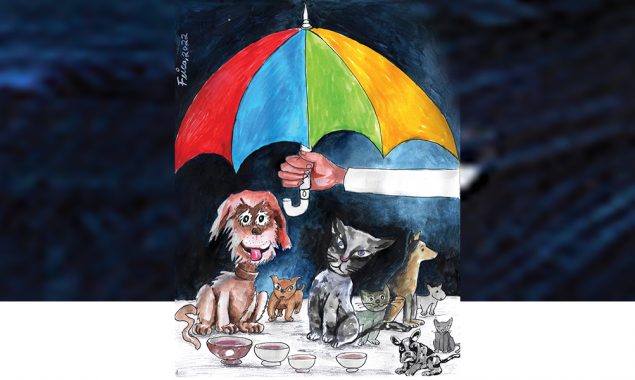Synopsis
Urban wildlife faces challenges including lack of shelter, food in major cities

Cartoon: Feica
LAHORE/KARACHI: A life of uncertainty and despondency has become the ultimate reality of the urban wildlife in the largest cities of the country, particularly Lahore and Karachi.
The cities’ stray animals, particularly the dogs and cats that come across every citizen who steps out of their doorsteps, are now facing deprivation of many forms. These animals, who lost their natural habitats decades ago due to the rapid urbanisation of Lahore and Karachi, have also been deprived of their freedoms.
From poor health, reduced life spans, physical abuse to mere ignorance, inhumane behaviour of the city dwellers and the psychological disorders caused by human neglect, urban wildlife has been left to fend for themselves.
Is urban wildlife doomed?
Animal rights activist Sarah Gandapur, who also serves at Sayaa Animal Welfare, told Bol News that it’s one thing that you received millions of rupees in donor funding from abroad to take care of the animals and another to spend from your own pocket to protect and nurture vulnerable animals.
“The current state of animals in Punjab is worse than ever. The killing of street animals has been on the rise more than ever. They are not safe on the streets, pets are not safe at home due to the rise of theft of pets. In certain areas, there [are] even kidnappers who openly demand money in exchange for the abducted animals. As an activist, I am only saying this after seeing the evidence myself”.
After the failed promises of the Punjab government, the situation has become clearer that cases of the killing of harmless animals are increasing, claimed Gandapur.
“The housing society authorities are also taking the law in their hands and are poisoning dogs. Hundreds of dogs have been killed this way. Such inhumane practices are beyond words. The pet markets are full of stolen animals and the commissioner Lahore has tried to help but seems unsuccessful so far. The misery of the voiceless animals is criminal and unacceptable”, Gandapur regretted.
“There is supposed to be complaints of stray dogs biting humans particularly children as the dogs who have contracted rabies are and should be considered ‘dangerous’. Yet, these cases are significantly low and can be easily tackled if the provincial government is serious and committed to the cause and start a full-on urgent execution of TNVR campaigns across the region”, the activist urged.
“The physical safety of stray animals is a major issue; they are always at risk of being poisoned or just plain shot.
“If the animals have been neutered or spayed that too will help as the street dogs end up not reproducing. In my view as an animal rights activist, I believe the answer to our dog population problem is not as complicated as it may seem. If the dogs are vaccinated, spayed/neutered their aggressive nature will change to a more docile and relaxed one. The related study and research have proven as it is not against animal rights to have them neutered or spayed”, she informed.
Equality for all
Allia Bukhari, who works as a journalist and is an animal lover said, “I do think the emotional wellbeing of urban wildlife is largely ignored in our cities, especially stray animals. I have not seen any improvement in animal welfare either and the quality of life of most of the animals is still quite poor. The fact behind the Karachi Zoo animals and the culling of stray dogs, time and again tells us that.
Neutering of dogs is a solution to control their population. Rabies vaccines should be made available. Stray dogs should be vaccinated and the general public should be taught to be kind towards them. There should be a fine or penalty for abusing the animals, I do not really know if there’s much attention given to animal rights as a whole or if there’s such a law in place. Even if there is one, probably no one really cares about it”, Bukhari regretted.
“Animals and especially dogs’ seemingly hostile behaviour towards people is because of the people throwing stones at them and displaying aggression. Dogs are wild animals they will respond back with behaviours ranging from aggression to stalled maturation”, she said.
“Stray dogs are equally loving. They should not be discriminated; I have seen a trend in Pakistan where it is a ‘fashion’ to pet foreign breeds when our climate doesn’t even suit them. Meanwhile stray dogs are treated worse. It has become a status symbol to pet other breeds. Stray dogs should be our priority as they are in much need of affection and love. I have rescued a stray dog and pet her now. This has helped me develop a strong connection with my dog”, Bukhari said while sharing her experience.
The appearances problem
The people who have kept pets at some stage of their lives know that there is variation in pet appearances and people openly show preferences for them.
Rayan Ali, a pet keeper who has raised many kinds of animals including cats, chicks, cows, goats and fish stated, “The issue of selective pet keeping isn’t about how common or uncommon cats or dogs or hamsters are. Having a cat or dog doesn’t make you ‘mainstream’. In a city where you have limited choice, people will adopt whatever animals they can best take care of. We don’t have the means to take care of other kind of animals. People simply adopt those that are easy to keep or those popularly modelled on their social media feeds. When all you get to see is this, then that’s all you would do.
“Many a times certain videos have gone viral in our community of people physically abusing animals for pleasure. Our passive tolerance for animal cruelty by others around us and the fact that we do practically nothing to place protection mechanisms or do individual work to eliminate animal hunger, or give them shelter or medically treat them is tantamount to abuse itself”, he regretted.
“It is also important to understand that pet keeping, at the scale it is happening now in our cities, is a relatively recent phenomenon. People did not pet dogs before as much as they do now. Previously people only had them tied outside their homes for security purposes. Now, dogs are a favourite among our youth”, he said.
“Nowadays, keeping pets of a certain breed has become a sign of social class. This culture of selective pet keeping has been perpetuated by social media influencers, and the users have had serious psychological effects on people who desire to own pets for themselves. Simply put, some people prefer white cats or ‘snow white fluffy’ cats just because of their colour. Then there is also the problem of prejudice against black cats as they are widely viewed as ‘cursed’ by some people due to the centuries’ old myth. This stigma and the credulous beliefs passed down to the youth by their elders have plagued the black-coloured cats”, he claimed.
Bol News reached out to a number of officials in the Punjab Forest, Wildlife & Fisheries Department for statements on the overall wildlife conservation efforts in the country’s largest province. However, these requests were turned down on the pretext of preoccupation with ‘important meetings or a lack of authorisation to comment over the wildlife situation’.
To emphasise the need for transparency and lucidity while reporting on the precarious animal welfare situation in Punjab, Bol News put lot of relevant questions and requests to the Punjab Wildlife deputy director (DD) and the Punjab Wildlife secretary regarding the province’s wildlife situation, the financial state of the department concerned in 2021 and the efforts made to protect wildlife.
However, the wildlife DD as well as other department officials either did not respond to or, if they did, they did not answer the relevant questions.
It is quite clear that the unsuitable living conditions of urban wildlife have already had serious implications for the vulnerable animals.
In any equitable, modern city, all animals deserve a loving home and those who wish to help out animals deserve access to the facilities that make the protection of vulnerable cats and dogs possible. The extreme and unfavourable climate that stray animals face in rich cities like Lahore and Karachi is condemnable, to say the least.
The substitutes for their home, if any, that are provided are not sufficient to deal with the crisis. If the incompetent authorities believe this is the condition our urban wildlife deserve to live in, it is better that we release the animals back into the wild.
Civil society and other stakeholders who claim to deeply care about all living creatures should push for only those solutions that prioritised the survival and quality of life of all animals.
Read More News On
Catch all the Pakistan News, Breaking News Event and Latest News Updates on The BOL News
Download The BOL News App to get the Daily News Update & Follow us on Google News.




